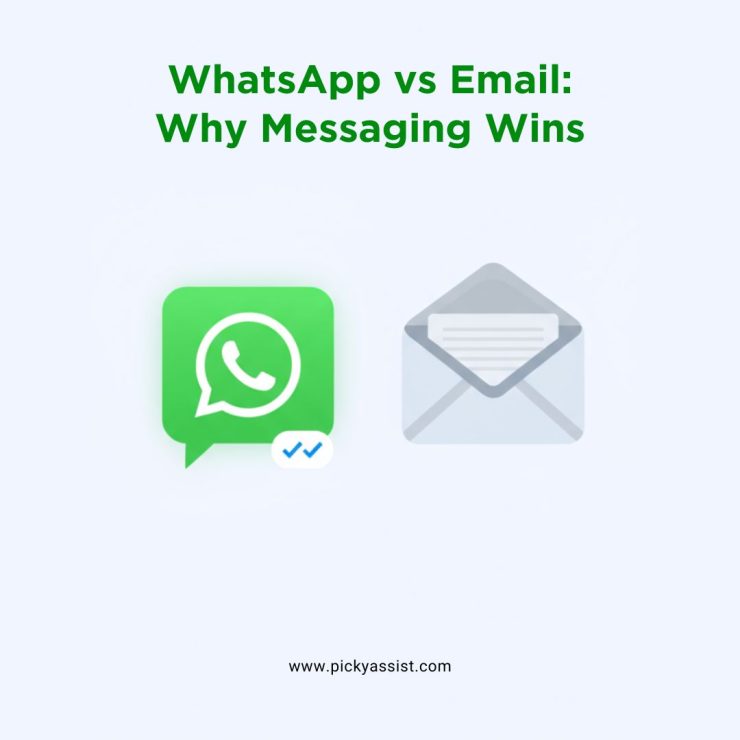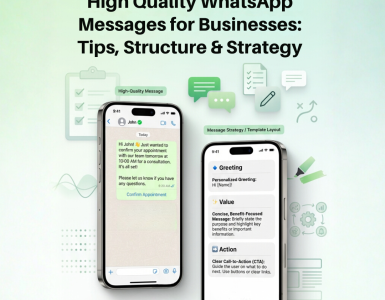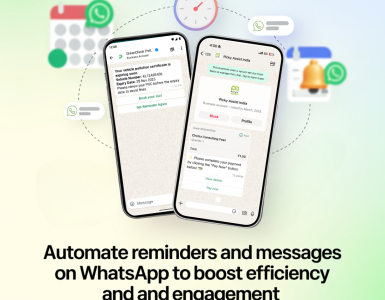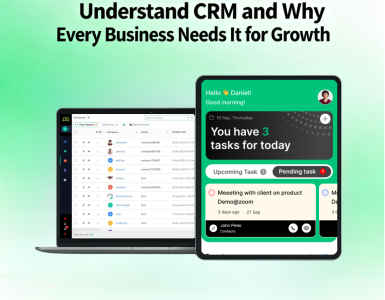In the case of any business communication, two channels dominate the conversation: WhatsApp broadcasts and email. Both are powerful, but the way they engage audiences is vastly different. If you are wondering whether to invest more in WhatsApp or email, the answer depends on your goals. This blog explores the advantages of WhatsApp broadcasts, compares them to email, explains costs, and shows why forward-thinking businesses leverage tools like Picky Assist to get ahead.
What Are WhatsApp Broadcasts?
Before diving into comparisons, let’s clarify what is a broadcast in WhatsApp. A WhatsApp broadcast lets you send a single message to multiple recipients at once, without starting a group chat. Each recipient receives the message as if it were a private one-on-one chat, maintaining privacy while maximizing efficiency.
With a broadcast list on WhatsApp, you can share promotions, announcements, newsletters, or updates instantly. This makes broadcast messaging particularly useful for businesses aiming for direct, real-time engagement.
WhatsApp Broadcasts vs Email: The Core Difference
- WhatsApp broadcasts deliver near-100% open rates because people check their WhatsApp more frequently than email. Messages land in personal chat windows, creating a more intimate connection.
- Email, on the other hand, supports long-form, formal communication, broader reach, and detailed analytics. It’s better for nurturing leads over time, sending detailed product guides, or official documentation.
Key takeaway: WhatsApp is unbeatable for urgent, interactive communication, while email excels in detailed, formal campaigns.
Benefits of WhatsApp Broadcasts
- Efficiency: Send one message to hundreds of people without sending it individually.
- Privacy: Recipients in a broadcast list cannot see each other.
- Business Use: Perfect for promotions, event reminders, newsletters, or product updates.
- Higher Engagement: Real-time delivery ensures customers see and respond quickly.
- Rich Media Support: Share PDFs, videos, images, or even voice notes, unlike plain-text-heavy email.
WhatsApp Broadcast Limits and Costs Explained
Understanding limits and costs is crucial when planning large-scale campaigns. (as of September 2025)
Here’s a standardized version of your three points:
- WhatsApp broadcast limit (Standard App): Up to 256 contacts per broadcast list.
- WhatsApp broadcast message limit per month (Small Businesses): 250 free messages per month for the first 180 days; charges apply after the free tier.
- WhatsApp business broadcast limit (API Users): No fixed limit on contacts; messages are billed under Meta’s conversation-based pricing.
WhatsApp Broadcast Costs
- Small Businesses (Standard App)
- Free tier: 250 messages/month for 180 days.
- After that: You pay per message delivered.
- Free tier: 250 messages/month for 180 days.
- Larger Businesses (API)
- Meta’s Charges: Pay per conversation (24-hour window).
- Categories: Marketing (higher cost), Utility, Authentication.
- Factors: Only delivered messages are billed, and charges differ by region and message type.
- Meta’s Charges: Pay per conversation (24-hour window).
- Additional Costs
- If you use a provider like Picky Assist, Wati, or Twilio, they may charge platform fees on top of Meta’s rates.
- Costs vary by country, conversation type, and vendor.
- If you use a provider like Picky Assist, Wati, or Twilio, they may charge platform fees on top of Meta’s rates.
Tip: Always check Meta’s pricing page and your solution provider’s fee structure to estimate the exact WhatsApp broadcast message cost for your business.
Why Does WhatsApp Messaging Wins Over Email?
- Higher Open Rates: Emails may sit unread, but WhatsApp messages are opened almost instantly.
- Personal Touch: Conversations feel one-on-one, even if sent via a broadcast list.
- Immediate Interaction: WhatsApp supports real-time responses, unlike the slower pace of email.
- Rich Media Delivery: Share videos, voice notes, and files seamlessly.
- Cost-Effective at Scale: While you pay for advanced API use, the engagement levels justify the spend.
Email still has advantages for formal documentation, brand building, and long-form storytelling. But for urgent campaigns, WhatsApp messaging wins hands down.
Picky Assist: Supercharging WhatsApp Broadcasts for Enterprises
For enterprises managing thousands of customer interactions, Picky Assist transforms how you scale WhatsApp broadcasts:
- Automation: Schedule recurring campaigns or trigger messages based on user actions.
- CRM Integration: Sync with your sales stack to nurture leads efficiently.
- Advanced Analytics: Track delivery, clicks, and engagement in real time.
- Overcoming Limits: API-powered broadcasts allow enterprises to go beyond the WhatsApp broadcast limit of 256 contacts.
This makes Picky Assist a robust solution for businesses seeking both scale and personalization. Unlike basic apps, it ensures compliance with Meta’s pricing, gives transparency into WhatsApp broadcast message costs, and maximizes ROI through automation.
Strategic Approach: WhatsApp + Email
The smartest brands don’t choose between WhatsApp and email; they combine them:
- WhatsApp: Use for urgent updates, interactive campaigns, and time-sensitive offers.
- Email: Use for newsletters, in-depth guides, or formal documents.
Final Thoughts
When it comes to instant, personal engagement, WhatsApp broadcasts clearly outperform email. They deliver higher open rates, stronger engagement, and more meaningful connections. While email remains essential for formal and long-form communication, businesses looking for immediacy and intimacy must prioritize WhatsApp.
With tools like Picky Assist, enterprises can overcome WhatsApp broadcast limits, manage costs effectively, and automate large-scale campaigns without losing the personal touch. In today’s digital-first world, the brands that win are the ones that combine speed, personalization, and scale; and that’s exactly what WhatsApp messaging delivers.
FAQs on WhatsApp Broadcasts
Q1. What is the difference between WhatsApp broadcast and chat?
A WhatsApp broadcast sends the same message to many recipients privately, while a chat is a one-on-one or group conversation.
Q2. What are broadcasts on WhatsApp?
They are a feature that lets you send messages to multiple recipients simultaneously via a broadcast list without revealing other recipients.
Q3. Is WhatsApp broadcast free or paid?
It’s free for up to 250 messages/month for the first 180 days on the standard Business app. Beyond that, costs apply, especially with the API.
Q4. How to activate WhatsApp broadcast?
Open WhatsApp, go to Chats → Menu → “New Broadcast” → Add contacts → Create.
Q5. What is the WhatsApp broadcast limit per month?
Standard app users get 250 free messages/month for 180 days. Larger businesses with the API face no strict monthly limit but must pay Meta’s per-message fees.
Q6. Can WhatsApp broadcast recipients see each other?
No, each recipient sees the message as a private chat.
Q7. How do I know if someone read my broadcast message?
Blue ticks confirm that a recipient has read your broadcast.
Q8. How do you know if someone is broadcasting you on WhatsApp?
There’s no notification; messages appear like regular chats.
Q9. What is the difference between WhatsApp announcement and broadcast?
Announcements are for groups (all members see replies), while broadcasts are private one-way messages to multiple recipients.







Add comment